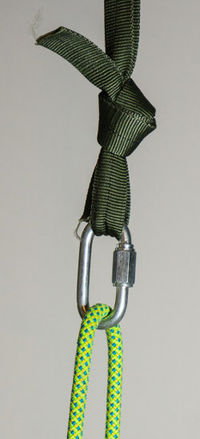Anchor ring

An anchor ring is a metal ring, usually a quick link or rappel ring, fixed to an anchor, through which a rope is rigged. The ring prevents rope-on-webbing contact, preventing webbing used to construct the anchor from being damaged and making pulling rope back through the anchor from the bottom easier.
Riggings[edit]
Because most canyoneering routes are through trips rather than in-and-back trips, the group must be able to retrieve the rope from the bottom of the rappel after the group has finished rappelling. Most systems accomplish this passing a length of rope as long as the drop through an anchor ring, and then dropping rope on both sides of the anchor ring to the ground when the last person rappels. This requires twice as much rope as the length of the drop, but it allows the group to retrieve the rope by pulling on one side of the rope so that the other side of the rope travels back up the rappel, back through the anchor ring, and then falls to the ground.
Many additional riggings start with this setup and then add additional features. These riggings include:
Dye Clan describes and compares a number of anchor ring rigging systems.
Advantages[edit]
In addition to protecting webbing used in the anchor from being damaged when the rope is retrieved, anchor rings make many types of rigging possible by providing a constriction through which the rope can pass, but not a larger object, thus creating a block.
Without a ring, pulling the rope through a loop of webbing, especially a wet, sandy rope, will create enough friction to burn the webbing, possibly to the point of the webbing being unsafe. Future parties might rig without careful examination of the webbing.
The friction of rope-on-webbing can make retrieving the rappel difficult or impossible, especially on longer rappels.
Disadvantages[edit]
Unless a retrievable anchor is used, an anchor ring will be left behind on every drop where one is used. This means that a leader must purchase many anchor rings, and leave non-natural objects in the canyon, cave, or other natural area.